Indian Folk-art: An Expression of Cultural Diversity
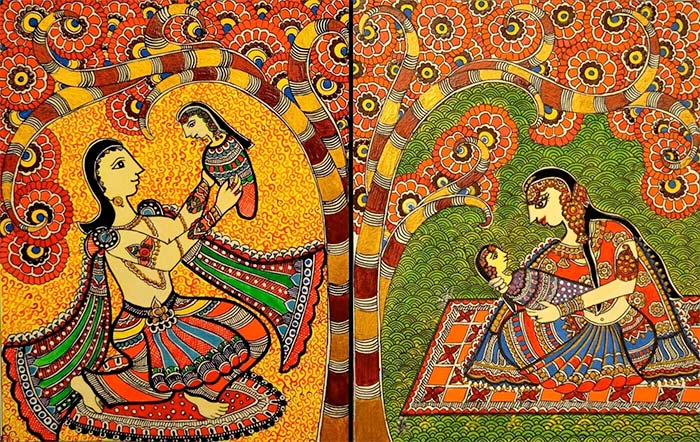
India is a religious and ethnically diverse country. Indian culture is characterized by distinct languages, and rich traditions among various ethnic and religious groups. Despite hosting a Hindu-majority it is difficult to attach a singular and unifying notion of identity to Indian culture. This is in part due to the flexible nature of the Hindu religion which allows for the aggregation of numerous regional cultures, and ethnic practices to grow and flourish. The folk and tribal arts of India express the cultural diversity of the nation and provide a window through which one can explore the rich heritage of Indian culture. 1
What is Folk-art?
Folk-art as a visual medium does not have a unique definition but generally consists of all forms of visual art delivered in the context of an existent society within a particular geographical and cultural niche. In this manner, folk-art caters to local tastes and needs, is reflective of the way of life and culture in a community, and provides tangible and intangible forms of art with distinctive styles and objects that stand removed from other cultural developments of their time. 2 3
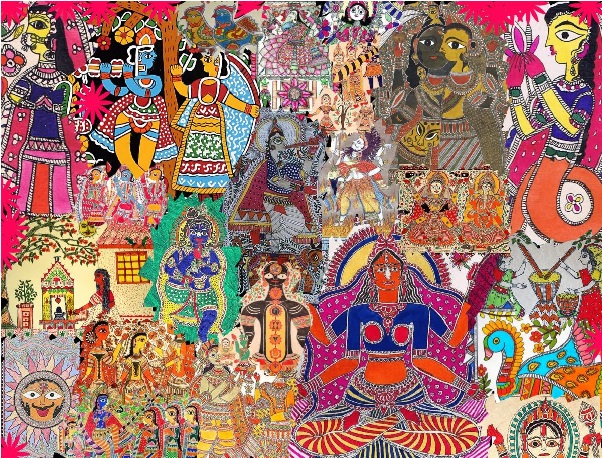
Intangible folk-art forms include music, dance, and narrative structures, while tangible folk-art forms refer to objects that are crafted by hand or other means within the traditional practices of a community. The purpose of folk-art is to serve as a medium through which a community’s traditions, beliefs, and attitudes can be transmitted and passed from one generation to another. This is often achieved within families and community via practical demonstrations, conversation, and daily practice. 4
Folk-art was developed to address the very real needs, and desires of a community. Once that need is removed, the relevant folk-art may gradually vanish within the annals of history thanks to decreased transmission and communication of its existence within the community. 5
Indian Folk-Art
Folk-art in India manifests in various forms including pottery, painting, paper-art, weaving, sculpting, metallurgy, and object design involving jewelry and toys. Relevant objects can include masks that are used in religious rituals and ceremonies, paintings, textiles, baskets, kitchen utensils, arms and weapons, religious sculptures (idols) etc. It is also common to have the human body serve as a platform for folk-art via the practices of piercings and tattoos during festivals and religious celebrations.
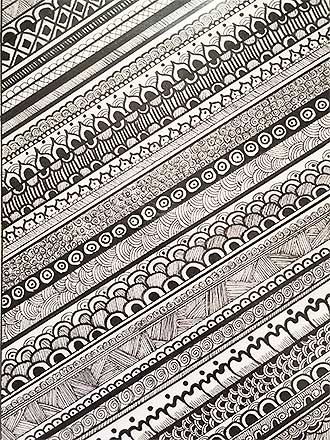
Folk-art products each have a symbolic meaning that is attached to them as well as the materials and techniques used to fabricate them. Easily recognizable forms of Indian folk-art include the dazzling sculptures and paintings of puranic gods and mythological figures of Hinduism often sold and displayed in temples, fairs, festivals, and city districts as well as in local households.
The Indian folk-arts have also served as a medium of expression for the cultures of nomadic tribes and ethnic groups within the country. The relevant art forms express the transient and dynamic patterns of lifestyles said communities have experienced while traveling across India. 6
Over the course of Indian history, the various folk-art forms of the nation have been protected and survived under the umbrella of religious and ethnic traditions revolving around familial beliefs, and daily practices. Unfortunately, globalization has resulted in the development of a synthetic macro-culture that has led to the gradual attrition of Indian folk-art. Thus, tremendous efforts have been undertaken by the government of India alongside various NGOs to preserve and protect these arts and to promote them. 7 8
In this article, we will consider five of the most popular and widely recognizable folk-art forms of India that have survived the passage of time.
Thanjavur Art
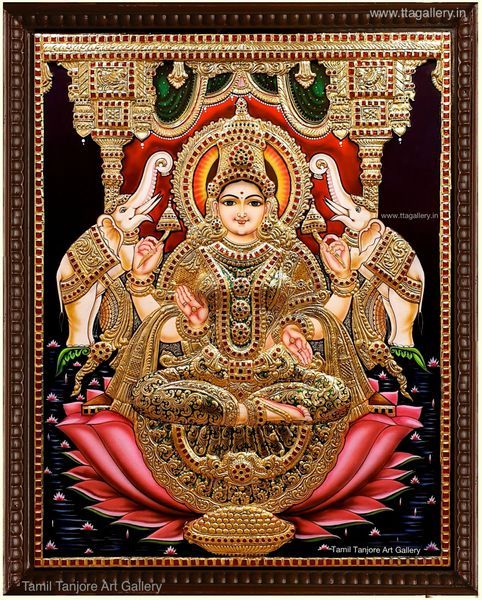
Tanjore or Thanjavur paintings originate from the South Indian state of Tamil Nadu, in the city of Thanjavur, about 300 km from the state’s capital city of Chennai. These paintings are essentially “religious paintings with a royal heritage” and are among the greatest traditional art forms noted worldwide. 9
The subject matter of these paintings largely revolve around mythological themes from Hinduism and demonstrate spirituality within the essence of creative art. Once adorning the royal dwelling of the Hindu rulers of Vijayanagar Rayas and Thanjavur Nayaks in the 16th century, these paintings can now be commonly found in every household with figures of Lord Krishna in various poses and depictions of his life being the most popular.
Thanjavur paintings are characterized by remarkable gold leaf work, brilliant color schemes, decorative jewelry with stones and cut glass. The paintings used to be adorned with rubies, diamonds and other precious gemstones, but nowadays, semi-precious stones are used in their place while the practice of using gold foil hasn’t been altered. The paintings are made such that the shine and glean of the gold leaves used last forever. 10
Madhubani Painting
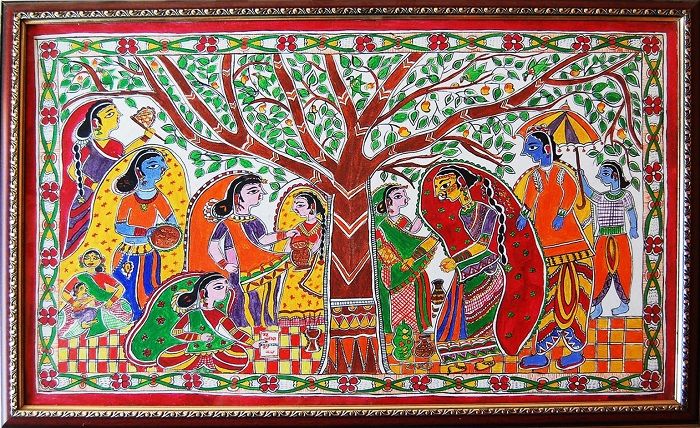
Also referred to as the art of Mithila, Madhubani paintings are said to originate from the kingdom of Janaka, who was the father of Sita in the much beloved Hindu epic Ramayana, in Nepal and in present-day Bihar. 11
The paintings are produced using mineral pigments prepared by the artists and were traditionally drawn on freshly plastered mud walls. For commercial purposes, the same has now been achieved on paper, cloth, canvas, and other media.
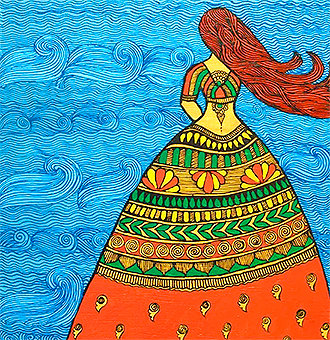
The method involves using cotton wrapped around a bamboo stick as the brush. Black color is obtained by mixing soot with cow dung, yellow from turmeric or pollen or lime and the milk of banyan leaves, blue from indigo, red from the kusum flower juice (from the Ceylon Oak tree) or red sandalwood, green from the leaves of apple trees, white from rice powder, and orange from palasha flowers.
The art form is characterized by geometric patterns and mostly depict scenes gods, weddings, flora, and fauna. Madhubani paintings are widely practiced by women as a means to cultivate their spirituality and yearning to be one with God. In fact, the All India Handicrafts Board and the Government of India have encouraged female artists to produce said paintings on handmade paper for commercial sale. In this manner, the Madhubani paintings have become a primary source of income for many families. The paintings now serve as a tribute to the original women of Mithila who first developed the techniques of said wall paintings. 12
Warli Painting
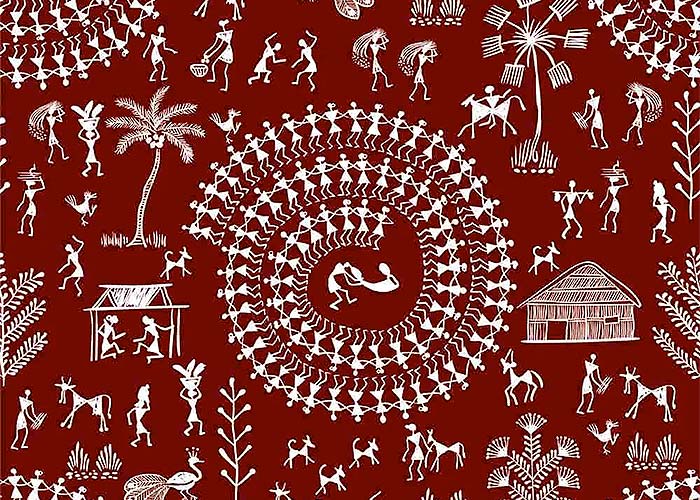
Warli is one of the oldest art forms of India and originates from the Warli tribe found on the northern outskirts of Mumbai in Western India. Despite their close proximity to one of the largest metropolitan cities in India, Warli culture is distinct in shunning all influences of modern urbanization. 13
Warli tribal art is representative of this attitude and mainly uses geometric structures such as circles, triangles, and squares to depict daily and social events of the Warli tribe. Compared to the Madhubani paintings, Warli art is quite simple. The paintings are often done on a red ochre or dark background, while the shapes are white in color. This color is obtained from the grounding of rice into white powder. 14

Humans are represented by a circle and two triangles, and through the paintings the Warli believe they can invoke the powers of their gods of worship. Altogether, the paintings are reminiscent of prehistoric cave paintings in execution and depict human figures engaged in hunting, dancing, sowing, and harvesting. The paintings are traditionally done in the homes of the Warlis and have served as a means of transmitting stories and traditions to a populace not acquainted with the written word. Warli paintings on paper have now become very popular and are sold all over India. 15
Pattachitra Painting
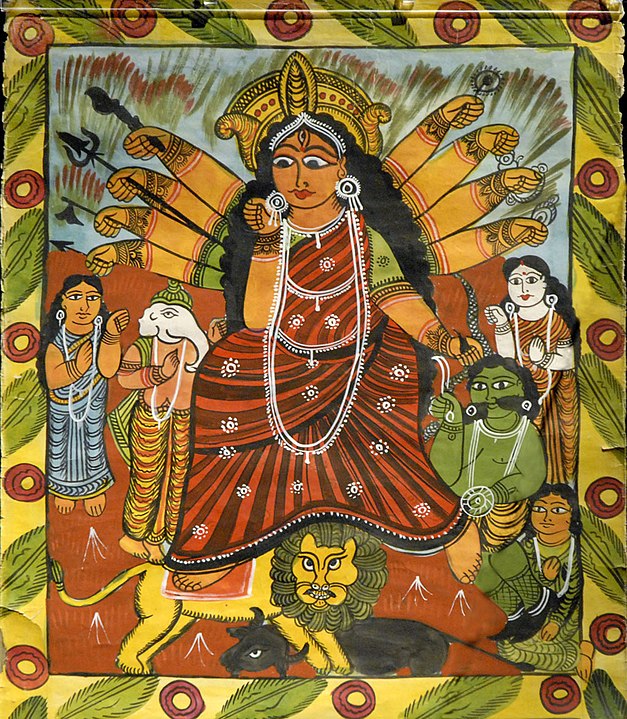
An east-Indian counterpart to the Warli as one of the oldest and most popular art forms of India, we find Pattachitra paintings from Odisha. The word Pattachitra is a combination of the Sanskrit words patta (canvas), and chitra (picture), and is basically a canvas painting.
The preparation of the canvas is among the most important aspects of a pattachitra painting. The painters, also called chitrakars, achieve this by preparing tamarind paste (by soaking tamarind seeds in water for three days). The seeds are crushed, and heated in an earthen pot to turn into a paste or niryas kalpa. The paste is used to hold two pieces of cloth together with it, and coated with a soft clay stone powder to keep it firm.
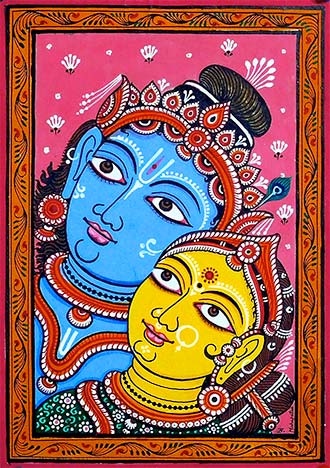
Once the cloth has become dry, it is polished with a rough stone and the surface is made smooth to become a canvas upon which the painting is made. The paints for the pattachitra originate from the gum of the kaitha tree which serves as the primary base for the various pigments to be generated. Powdered conch shells are used to make white pigments while lamp soot is used for black pigments. The root of the keya plant serves as a course brush, while mouse hair attached to wooden handles serve as finer brushes.
Pattachitra paintings are popular sources of representation of the ten avatars of Lord Vishnu, the Krishna Lila – where Vishnu’s avatar Krishna displayed his powers, and the depiction of Lord Ganesh as a five-headed deity. Nowadays, pattachitra paintings have also been made on other media including tussar silk and palm leaves, and are frequently used as wall hangings and showpieces. 16
Kalamezhuthu
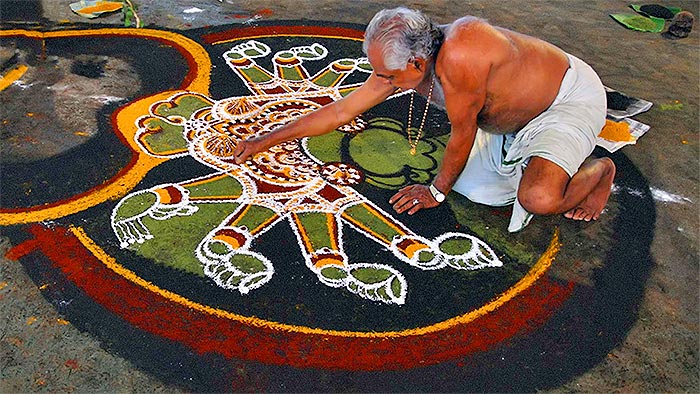
Last, but not least, the Kalamezhuthu comprises a form of folk-art that is among the most recognizable of Indian folk art. Popular variants or counterparts to the Kalamezhuthu include the Rangoli and Kolam or mandalas observed in the domestic routines of Hindu and Indian households in general to draw patterns at the doorstep and courtyard to welcome a deity into the house. 17
Kalamezhuthu specifically comprise of the tradition of drawings found at the entrances of homes and temples. This folk-art form is unique to the south Indian state of Kerala and is practiced in temples and sacred groves where the representations of Hindu deities are made on the floor. The drawings are made using natural pigments and powders of five colors (white, black, yellow, red, and green) and are done with bare hands without the use of tools.
The beautiful patterns are drawn from the center and grow outwards. Lighted oil lamps are often utilized at strategic positions of the patterns to brighten the colors. The patterns themselves are decided in observance with strict religious rules and unlike in rangoli and kolam are rarely made by the choice of artist.
The completion of the Kalam is accompanied by the singing of ritual songs in worship of the deity that is being celebrated. The songs themselves are part of an oral tradition with the rituals being performed by the artists themselves in a folk-art form that combines tangible and intangible media. Upon completion of the rituals, the “kalam” is immediately erased. 18
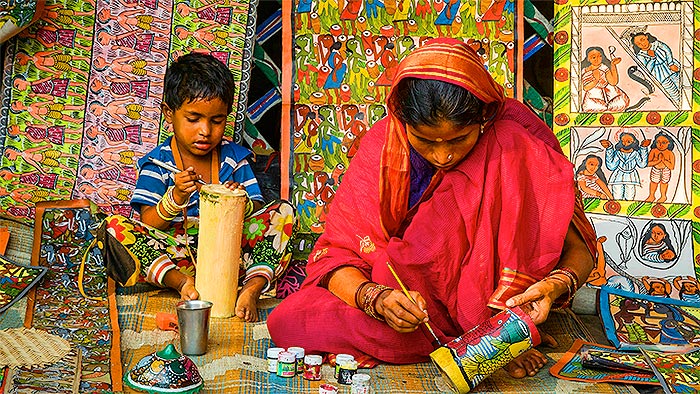
Indian folk-art abounds in expression of the country’s rich heritage. Indian art forms are diverse and exquisite in nature but also explicit in their use as a media of communicating ancient oral traditions. With 29 states and 7 union territories, each with their own distinct cultural and traditional identities, India boasts a collage of folk art forms that speak volumes about the country’s diverse cultural identity that is rooted in the daily lives of its people.
Works Cited
- “Folk and Tribal Art”. Know India. Culture and Heritage. Visual Arts and Literature. National Informatics Centre, Government of India. 2005. ↩
- https://www.ukessays.com/essays/cultural-studies/introduction-to-indian-folk-arts-cultural-studies-essay.php ↩
- Wertkin, Gerard C. (2004). “Introduction”. In Wertkin, Gerald C. (ed.). Encyclopedia of American Folk Art. New York, London: Routledge. pp. xxvii–xxxiii. ↩
- Wertkin, Gerard C. (2004). “Introduction”. In Wertkin, Gerald C. (ed.). Encyclopedia of American Folk Art. New York, London: Routledge. pp. xxvii–xxxiii. ↩
- Wertkin, Gerard C. (2004). “Introduction”. In Wertkin, Gerald C. (ed.). Encyclopedia of American Folk Art. New York, London: Routledge. pp. xxvii–xxxiii. ↩
- https://en.wikipedia.org/wiki/Folk_art ↩
- GVSS, Gramin Vikas Seva Sanshtha (12 June 2011). “Evaluation Study of Tribal/Folk Arts and Culture in West Bengal, Orissa, Jharkhand, Chhatisgarh and Bihar” (PDF). Planning Commission. Socio-Economic Research (SER) Division, Planning Commission, Govt. of India New Delhi. p. 53. Retrieved 2 March 2015. … globalization has triggered the emergence of a synthetic macro-culture…is gaining popularity day by day and silently engineering the gradual attrition of tribal/folk art and culture. ↩
- “Decline of tribal and folk arts lamented”. Deccan Herald. Gudibanda, Karnataka, India. 3 July 2008. Archived from the original on 2 March 2015. Retrieved 2 March 2015. In the wave of electronic media, our … ancient culture and tribal art have been declining, …, said folklore researcher J Srinivasaiah. ↩
- https://knowindia.gov.in/culture-and-heritage/folk-and-tribal-art/tanjore-art.php ↩
- https://knowindia.gov.in/culture-and-heritage/folk-and-tribal-art/tanjore-art.php ↩
- https://knowindia.gov.in/culture-and-heritage/folk-and-tribal-art/madhubani-painting.php ↩
- https://www.thebetterindia.com/53993/10-indian-folk-art-forms-survived-paintings/ ↩
- https://www.thebetterindia.com/53993/10-indian-folk-art-forms-survived-paintings/ ↩
- https://knowindia.gov.in/culture-and-heritage/folk-and-tribal-art/warli-folk-painting.php ↩
- https://theculturetrip.com/asia/india/articles/indian-folk-arts-evolution-and-diversity/ ↩
- https://knowindia.gov.in/culture-and-heritage/folk-and-tribal-art/pattachitra-painting.php ↩
- https://knowindia.gov.in/culture-and-heritage/folk-and-tribal-art/kalamezhuthu.php ↩
- https://www.thehindu.com/society/history-and-culture/kalamezhuthu-when-art-is-integral-to-ritual/article25622568.ece ↩
What do you think? Leave a comment.











The Moghuls were steeped in Persian Architecture and Art. Persian esthetic became the cannon for both the Moghuls and their Indian feudatories, especially in Architecture and miniatures. It would be most interesting not only to discover the biographies of individual painters but also how the techniques of miniatures became “incultured” to Hindu and Shia Muslim Artists.
Reading about the history of the Moghuls you can easily see how steeped the Persian culture was infused with Indian culture and vice versa. As an Indian citizen, who was lucky enough to visit the Middle East as well as other African nations, it was an enlightening experience to see how the various cultures had intersecting facets of daily life and practices from something as simple as the cuisines to religious practices and art.
Thank you very much for writing this article. I love everything about India and also to see how fabric, pots and many more diffrent products made traditionally by hand – they are awesome.
Thank you for reading the article!
That was truly a great insight on the difference Indian Folk Arts. Now i can easily identify these paintings.
Glad to know it helped!
For me, being a student, its a revision of social studies I learnt from class 6th & 7th in a good way. 14 years later you guys are reminding me values and morals of my culture. On such a platform, nobody doing this better than The Artifice.
Beautiful pictures and eloquent analysis. It was a pleasure to read. I look forward to any future articles you write.
Thank you!
A fascinating insight into Indian folk art. I confess I was quite ignorant of the breadth and scope of Indian folk art before helping in the editorial stage for your article, so your writing has been an education for me. Thank you for all the time and effort you put into this work. I was particularly intrigued by the idea of the Kalam being erased immediately after the completion of the rituals. I suppose that act of erasing could be interpreted as an expression of the only permanence in life being change. All things must pass – even beautiful art.
I absolutely love your perspective on the kalam, and in fact, that is part of what I was taught growing up as a kid in India. The notion of change as the eternal constant is fundamental to Indian philosophy but also many others in the Asian subcontinent. It is that unifying feature that also serves to make the Indian culture more diverse in its ability to connect with several different cultures.
These intricate, beautiful art have such a rich and evocative feeling to them. Thanks for the introduction!
Thank you for reading!
Stunning art. Thank you for sharing the history. India is a beautiful country. I have many friends from Gunter, Mumbai, Calcutta, and Bangalore who I know personally. India has a special place in my heart.
With all its beauty, so much sadness and poverty exist; I work with several orphanages in those cities.
Beautiful! Thank you for sharing about this culture so I can learn more about it.
There is an interesting tradition the women in the Northern Bihar have of decorating their walls by painting intricate patterns on them during religious ceremonies or weddings.
Mithila is the home of Sita, a prominent figure in the Hindu religion and wife of Rama. Mithila is indeed considered to be the modern day Bihar. What you are referring to is in fact the Mithila paintings or the Madhubhani paintings I have described in the article.
India has rich heritage of traditional art!
There are different types of tribal & folk paintings all over India and each of the styles are different from the others. My favorites are cave paintings.
My favorite is Batik Art.
From what I can see of the paintings here, they are extraordinary in their vibrancy. I think artists are drawn towards subjects which fascinate them.
Absolutely, I think the vibrancy and the diversity of Indian folk art is a beautiful reflection of the diversity of thoughts, ideas, and facets of the Indian culture.
Wonderful Paintings!
While admitting that I have no knowledge of the technicalities about paintings, when my neighbour’s five year daughter showed me a similar work I said “wonderful painting”.
I wish I wish I could go and learn In India. What amazing art they have there.
Great post. Indian folk art is still alive in many parts of the country. They’re all unique, admirable and beautiful in their own ways.
Madhubani is an amazing part of our rich art and culture. I’d visited the National Crafts Museum last year and was amazed to see the various styles of paintings. Thanks for this amazing post.
I’m a huge fan of madhubani paintings. The motifs, the color and the link to ancient tales. Fantastic!
Living so close to madhubani, I never got a chance to see the paintings. These are really beautiful and vibrant.
So inspiring and motivating… shows Indian culture in the truest sense.
When I see people like you who really values our culture and our beliefs then it makes me happy and by the way I am from Mithila region.
I love how Madhubani literally translates into honey forests.
I love them. The paintings are known for their simplicity, line work and vibrant colors.
Wonderful, educative and enlightening.
Lovely, I always adore indian folk art.
I had an indian art session with my students. The children were delighted with their finished pieces!
They look so beautiful. Absolutely arts!
Lovely article. Enjoyed seeing the bright pictures and different forms of Indian arts
Lovely folk art!! To deliver something like this quality require a lot of hard work. Salute to these people to keep this ancient art live today.
Wonderful insight into these highly intricate creative processes. I enjoyed your infusion of history with the process as an explanation of the symbolism and diversity of Indian folk art.
Absolutely enchanting article! I love the description of all the natural elements used to create the Madhubani paintings.
This article was really insightful for me! As a creative myself, I never thought of how other places of the world engage with art and how it often is an expression of religious values and family traditions. Their art consists of so much time and effort to prepare the materials. This article I think helped me appreciate art even more from other places because of the intentionality put into them. That’s awesome.
So cool. I’ve always been fascinated by Indian art because of the eclectic color palette and intricacies of the work. You’ve selected beautiful pieces to accompany a very informative article.
This was such a great introduction to Indian Folk-art! I found it interesting to learn about the preparation of the canvases in Pattachitra Paintings.
As a proud compatriot, it really pleased me to see this topic on the Artifice and how well you handled it. Given the current grim scenes I encounter on a regular basis due to COVID, this article pleasantly reminded me of my childhood days where I spent more than a year exploring temples across South India, particularly Kerala. The richness of folk art is something that never fails to astound me on a daily basis and the more Income to know about India’s rich cultural legacy, the more spellbound I am.
Great article, India is host to over 50 folk art forms. Tanjore, Madhubani, Pattachitra, Warli are some of the folk arts that managed to survive.
Pattachitra from Odisha
Patachitra from Bengal
Durgamata Patachitra comes under Bengali Patachitra, artist community known as Chitrakar or Patua.
I worked with Patuas Community, because the scroll narrative art of Bengal is my PhD topic which enabled me a doctorate degree.
I am fully grateful to the Artifice for depicting this worthy article on Indian Folk-art: An Expression of Cultural Diversity.